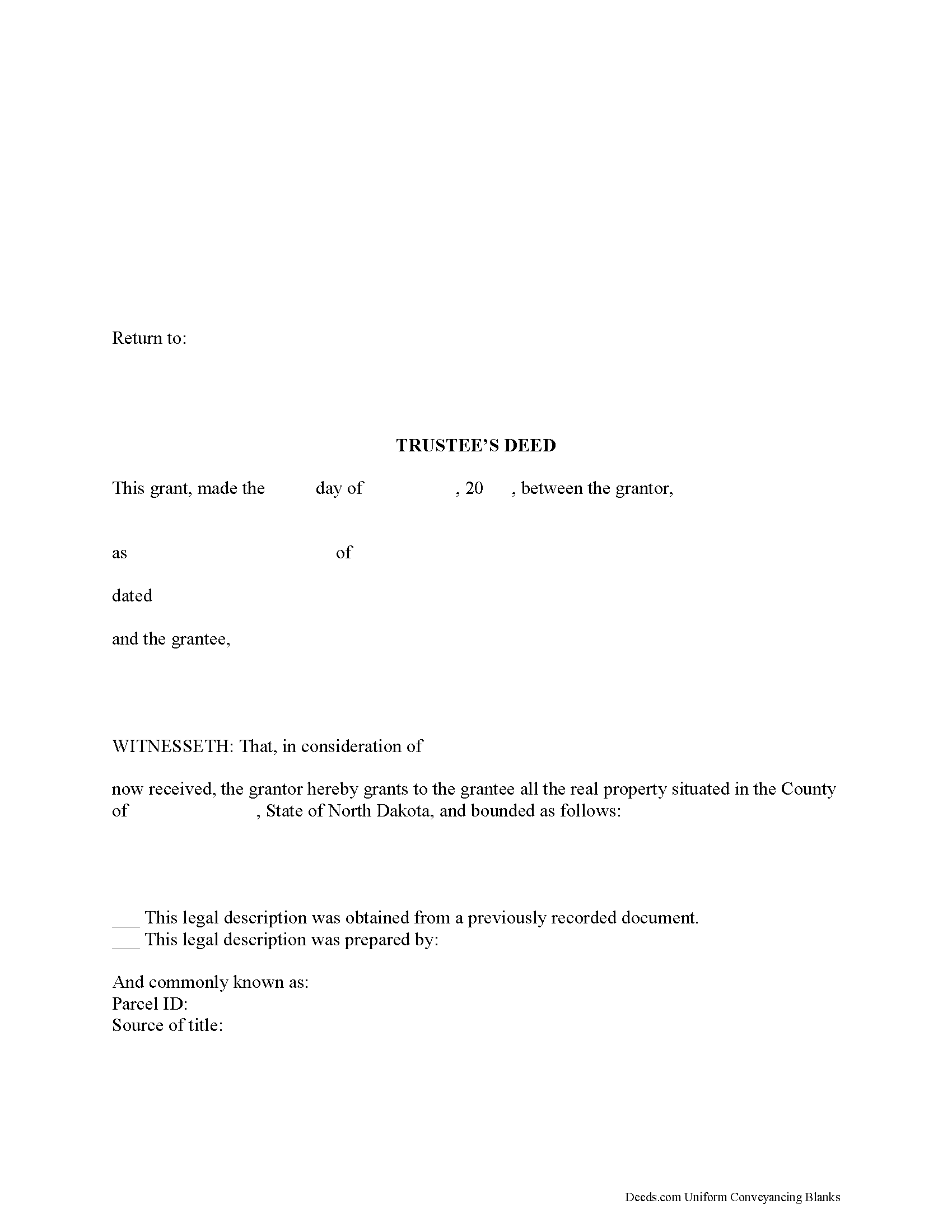Download North Dakota Trustee Deed Legal Forms

North Dakota Trustee Deed Overview

Transferring Real Property from a Trust in North Dakota
A trust is an arrangement whereby a person (the grantor or settlor) transfers property to another (the trustee) for the benefit of a third (the beneficiary). In general, trusts in North Dakota are governed by Chapters 59-09 through 59-19 of the North Dakota Century Code as the North Dakota Uniform Trust Code.
To create a trust, the settlor transfers property to a trustee either during his lifetime (an inter vivos trust) or by will upon his death (a testamentary trust) (N. D. Cent. Code 59-12-01). It must be created for lawful purposes and have a definite beneficiary, or a person with "a present or future beneficial interest in a trust, vested or contingent, including the owner of an interest by assignment or transfer" ( 59-09-05, 59-12-04; 59-09-03(3)(a)).
In North Dakota, trusts relating to real property are invalid without a written instrument signed by the trustee ( 59-12-18). The trust instrument is an unrecorded document executed by the settlor that "contains [the] terms of the trust, including any amendments to the record" ( 59-09-03(25)). In addition to designating the trustee (and successor, if the settlor also serves as the original trustee) and conferring specific powers upon the trustee, the trust instrument establishes the scope of trust's assets and identifies trust beneficiaries.
An inter vivos (living) trust is an alternate method of holding title to real property for estate planning purposes. The settlor transfers real property into the trust by executing a deed titling the property in the name of the trustee as representative of the trust. The trustee administers the trust according to the terms set forth in the trust instrument.
The trustee "is presumed to have the power to sell, convey, and encumber the real property unless restrictions on that power appear in the records of the county recorder" ( 47-140-26). The trustee's authority to convey property is further established by the statutory general power of trustees to exercise "all powers over the trust property which an unmarried owner, who is not an incapacitated person, has over individually owned property of the trustee" and the specific power to sell property, as established by the North Dakota Uniform Trust Code ( 59-16-15, 59-16-16(2)).
In order to convey real property out of the trust, the trustee executes a trustee's deed. The form of conveyance takes its name from the granting party rather than from the type of warranty of title given, as with a warranty deed or special warranty deed, for example.
In North Dakota, the trustee's deed is typically a special warranty deed passing fee simple title, containing the covenants that the grantor has not previously conveyed right, title, or interest to another person and that the property is free from encumbrances made by the grantor or persons claiming under the grantor. These covenants are implied unless explicitly stated otherwise in the form of the conveyance ( 47-10-19).
Because real property held in trust is titled in the name of the trustee on behalf of the trust, in addition to naming each acting trustee, the trustee's deed should reference the trust and date of execution of the instrument establishing the trust. A certificate of trust under 59-18-13 or trustee's affidavit is typically unnecessary, though in some cases is advisable. Consult a lawyer with questions.
Deeds executed by trustees must meet all the same requirements for form and content for documents affecting interests in real property, including a statement of full consideration and legal description of the property being conveyed. All acting trustee signatures, made before a notary public, should be present before the deed is recorded in the office of the recorder of the county in which the subject property is located.
(North Dakota TD Package includes form, guidelines, and completed example)